This is a series of articles on the temples of Nepal which I had the opportunity to visit with Balaji Davey and Mantra Yatra. This is not a paid partnership.
The first two parts of the series can be found here - Part 1& Part 2 .
Day 3 commenced at Pokhara. It was our base station before we set out on the Muktinath Yatra. Pokhara is the capital of the Gandaki Province and the second busiest city after Kathmandu. It is also known as the Trekker's Paradise as it serves as the base and recharge unit for all those who visit Nepal for mountain tourism and trekking. The word Pokhara comes from the Nepali word Pokhari which means lake and true to its name, the city is located next to the Phewa Lake. Pokhara has a rich history and heritage and has featured as an important part of the Indo - China and subsequently Indo - Tibet trade routes.
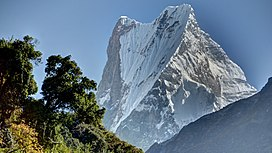
Close up of the fish tail (Pic: Google)
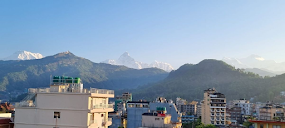
Machchapuchre from our hotel (Pic: Balaji Davey)
Machchapuchre:
Pokhara has several temples and we had an opportunity to visit a few of them, but before speaking about them, one has to mention Machchapuchre, part of the Annapurna range of mountains whose highest peak has never been climbed by mountaineers. Although much lower in height when compared to Mt. Everest, the Nepal Government has not given approval to anyone to set foot on the Machchapuchre (literally meaning Fish Tail, the name coming from the triangular shaped mountain with a twisted twin summit which gives the impression of a fish's tail)as it is considered holy by the Gurungs of Nepal. Jimmy Roberts, considered as the Father of Mountain Tourism in Nepal, seems to have come very close to have summitting it in 1957, but when weather and situations forced his group to return without reaching the summit, he understood and respected the wish of the Gurungs and requested the Nepal Government to keep it off-limits for the trekkers. Till date, Machchapuchre is considered among the holy peaks prohibited for those attempting to summit it, like Mt. Kailash.
Phewa Lake and the Tal Barahi Temple:
Phewa Lake is a freshwater lake on the shores of which stands Pokhara city and it is the second largest lake in Nepal. Since the lake is only 28 kilometres from the Annapurna range, it is common to see the reflection of Machchapuchre and the other peaks of the Annapurna range in the waters of Phewa. Therefore, thousands throng the lake set in pristine surroundings.
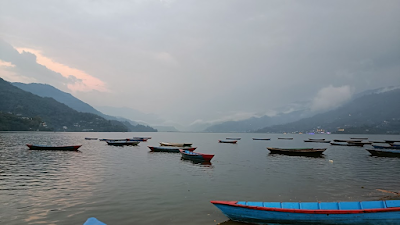
Phewa Lake in Pokhara, Nepal
The Phewa Lake not just serves as a tourist spot, and a popular shopping area (the lakeside is surrounded by shops that sell various items required by trekkers for the climb. It also sells clothing and other items for tourists, but the prices are steeper when compared to other areas) but also as a popular pilgrim location. At the center of the lake, in an island is the Tal Barahi Temple, which is the most important temple in Pokhara. This temple can only be visited by boat, and there are several boats that ply through the day to the temple.
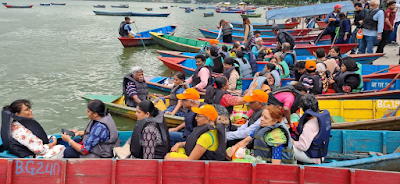
Boats getting ready to ply to the Tal Barahi Temple (Pic: Suresh Joshi)
Tal Barahi is considered to be a manifestation of Ajima, the Female Goddess of Protection in the form of a boar. Ajimas are worshipped by the Newars, both Hindu and Buddhist as a representation of their matriachal ancestors (Aji refers to grandmother and Ma to mother). They are said to protect the people, particularly the children from ill-health, disease and death. Cities had eight Ajima temples protecting all directions, known as the Ashtamatrikas.
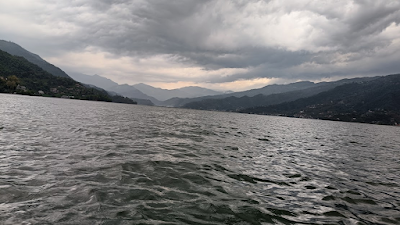
A view of the Annapurna range mid-way to the Tal Barahi Temple
The Legend of Tal Barahi
According to an inscription in the temple that describes the legend of Tal Barahi, a Jogi (ascetic) came to Phewa City (which existed where the lake now stands) and asked for food and shelter for the night. No one bothered but for an old lady who gave him rice and vegetables. The next morning as the Jogi left the house and moved towards the mountains, water came in to cover the entire area and everything and everyone drowned except for the old lady. Grateful that Goddess Bhagavati had saved her, the old lady started worshipping her in her house now surrounded by water as Goddess with a boar face - Barahi. After her death in 1467, the deity continued to be worshipped until King Kulamandan Shah, the first Shah ruler of Kaski built a two storeyed temple in Pagoda style in 1868. He initially installed the Goddess as a reed bush from the mountains.
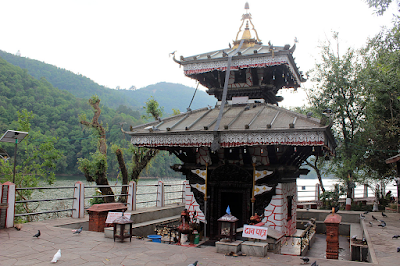
The original Structure of the Tal Barahi Temple Source: Google
The temple was damaged badly in the 2015 earthquake, after which King Mahendra renovated the temple in 2017. The original deity has been replaced and there is a small single storey construction with a silver deity and a few other idols near it.
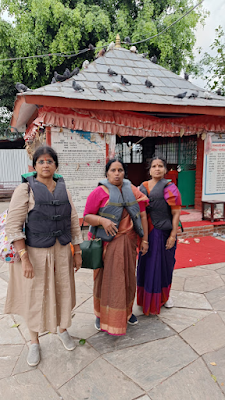
The current Tal Barahi Temple
Every evening, on the banks of the Phewa lake, the Tal Barahi Aarti is performed between 6 and 6.30 pm depending on the weather. Although it lacks the grandeur of the Ganga Aarti, it was heartening to see large crowds of pilgrims join to sing and dance as the aarti was being performed.
Bindhyabasini Temple
The Bindhyabasini temple is the oldest temple in Pokhara. Goddess Bindhyabasini is said to be the replacement for Lord Krishna, when he was born as the eighth child of Vasudeva and Devaki. The child disappeared in the air when King Kamsa tried to kill it and said to have reappeared in the Bindhyachal Mountain.
King Siddhi Narayan Shah had a dream of installing a temple for Durga for the unification of Nepal. So he ordered his men to bring a deity from Bindhyachal mountains. When his troop of men returned with the deity, they placed it in the current location at night to rest and in the morning the idol could not be moved. So the king agreed to build a temple where the Goddess had decided to stay.
The Bindhyabasini temple is very picturesque and is located atop a hill approximately 3000 feet above sea level. There are steps to climb up to the temple (a lift of recent origin is also available) from the old bazaar side.
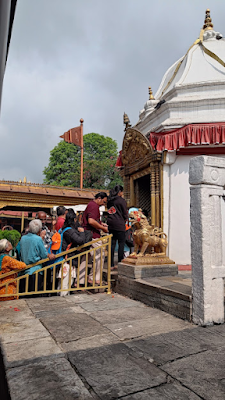
Devotees queuing up to worship Goddess Bindhyabasini
Goddess Bindhyabasini (seen as a form of Durga ) is seen in a seperate sanctum as a Shalagrama idol. The entrance to the shrine is covered with gold plating and guarded by two lions on either side. The shrine is built in Shikara style which is said to be older than the Pagoda style in which most of the temples in Nepal can be found. There are multiple shrines at the temple for Shiva, Ganesha, Saraswathi, Hanuman, Lakshmi Narayana, Radha Krishna and Sita Rama which are of a much later origin.
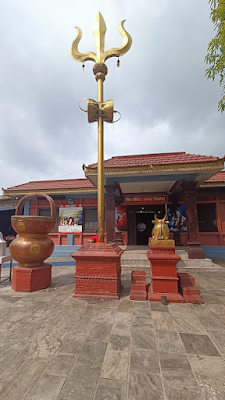
Lord Shiva shrine at the Bindhyabasini Temple
The view from the Bindhyabasini temple of the Annapurna and Dhaulagiri ranges of the Himalayas as well as the Pokhara city is breathtaking.
Gupteswar Mahadev Cave Temple
